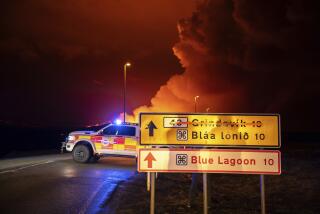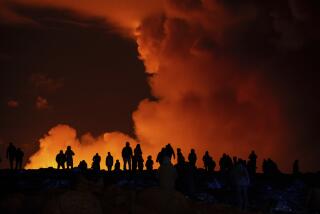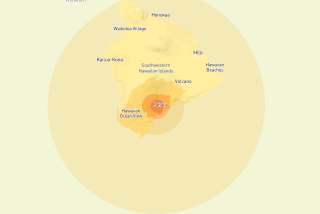Hawaii volcano puts on a show, but travelers won’t have ringside seat
Anyone hoping to witness Kilauea’s most recent drama up close is out of luck.
Kilauea, the Big Island volcano that’s been spewing lava for more than 30 years, in June let loose a stream of lava from a newly opened vent on its east side. The lava flowed 13 1/2 miles before stalling in late October. On Nov. 10, a localized breakout destroyed a house in Pahoa, in the isolated Puna district on the eastern tip of the island.
------------
For the Record
Nov. 20, 10:48 a.m.: An earlier version of this post incorrectly reported that only scientists and media have access to the Pahoa area. The restricted access applies to the lava flow, not the general area.
------------
Pahoa remains threatened, but it’s impossible to know when — or even whether — the molten rock might engulf this town of fewer than 1,000 people.
In fact, except for a couple of detour signs, you’d never know that the lava was expected to reach State Route 130, the main thoroughfare in or out of the district.
Yes, some businesses have closed, but for tourists to this area, it’s leisure as usual. Tiki DeGenaro, general manager at the Kalani Oceanside Retreat, about 15 miles from the flow, is unfazed and even appreciative.
“The old town [of Pahoa] is totally intact,” DeGenaro said. “The new town is totally intact. She’s [the lava] going right through the middle. And there are lots of alternative roads so we’re not concerned. Neither are our guests.
“We’re just shocked that Pele’s [the volcano goddess] being just as compassionate as she can be.”
(If Route 130 is closed, Railroad Avenue can pick up the slack — with an extra half-hour added to the one-hour drive from Hilo, she said.)
Only scientists and the media are allowed close-up access to the lava.
Janet Babb, a geologist at the USGS Hawaiian Volcano Observatory, said the current flow is beyond the boundaries of Hawaii Volcanoes National Park.
“It’s on a natural area reserve protected by the Department of Land and Natural Resources, and if it’s not on state land, it’s on private property,” Babb said.
The park is open, but the 2011 lava flow, which occurred inside and outside its boundaries and streamed dramatically into the ocean (once visible on volcano safaris), halted in August 2013.
Which is why helicopter tours were invented. Despite flight restrictions over Pahoa, Safari Helicopters, based in Hilo, will hover as close as 500 feet to Puu Oo, a “cinder/spatter cone” on Kilauea’s eastern zone that has been erupting continually since 1983.
Blue Hawaiian Helicopters departs from Hilo and Waikoloa, and Paradise Helicopters operates out of Hilo and Kona.
You probably won’t see 1,500-foot lava fountains similar to the ones that occurred in the ‘80s, but if Mother Nature cooperates you may catch that iconic red glow.
As for the June 27 flow, Babb can’t say when or even whether the lava will reach Route 130. But if it does, people will adapt.
“With lava,” DeGenaro said, “ ‘go with the flow’ has more than one definition.”
To learn more about the eruption, see Hawaii Volcanoes National Park volcano update page. The page also links to the USGS Hawaiian Volcano Observatory and the County of Hawaii Civil Defense.
Follow us on Twitter at @latimestravel
More to Read
Sign up for The Wild
We’ll help you find the best places to hike, bike and run, as well as the perfect silent spots for meditation and yoga.
You may occasionally receive promotional content from the Los Angeles Times.






